The most popular of plastic surgeries are those that are aimed at changing the shape, reducing the size, as well as correcting nose defects resulting from injuries or diseases. They are collectively referred to as rhinoplasty. According to statistics, this is one of the safest plastic surgeries.
Indications
Patients undergo this operation for a variety of reasons, which are divided into physiological (difficulty breathing) and aesthetic (improvement in appearance).
Nose reduction surgery is performed for the following indications:
- disproportionately long nose;
- large nostrils;
- Aquiline nose;
- the tip of the nose is too thick or pointed;
- saddle nose;
- change in the shape of the nose due to trauma or damage;
- defects in the shape of the nose, inherited;
- low back of the nose;
- there is a bulge in front of the tip of the nose;
- asymmetry of the nasal septa;
- Difficulty or almost impossible breathing through the nose, as a result of accrete or curved septa or other reason
Contraindications
Nose reduction surgery should be performed after examination in order to identify contraindications that may complicate the course of the operation or affect the final result of rhinoplasty.
Nose reduction surgery has the following contraindications:
- age less than 18 years, since the shape and structure of the nose is still being formed before the age of 18;
- atherosclerosis;
- diabetes;
- viral diseases (HIV, hepatitis C, acute herpes);
- inflammation of the skin of the nose;
- infectious diseases in acute forms;
- mentally unhealthy patient;
- diseases associated with poor blood clotting and heart problems;
- inflammation of the nasal, frontal sinuses;
- diseases of the oral mucosa.
Operations to change the shape or size of the nose are performed by two methods: closed or open. Which one will be chosen depends on the type of operation, the tasks set.
Open method
Plastic surgery to reshape or reduce the size of the nose is most often performed using the open method. The essence of this method is to make an incision at the edge of the wing cartilage and a columella incision. When the surgeon has made the incisions, the skin is pulled back to the bridge of the nose, thereby opening up access to the bone and cartilaginous tissue for further action to change.
Key benefits of open rhinoplasty:
- Since this is an external operation, the surgeon has the ability to visually monitor the progress of the work, making it easier to make changes or adjustments in the process.
- The fabrics do not turn inside out and do not stretch during the intervention, this makes it possible to put the fabrics in their places without distortion and apply seams without unwanted changes in shape.
- Even with severe defects in the anatomical structure of the nose, complex grafts can be placed.
- Achieving perfect symmetry of the nose after the intervention.
Open rhinoplasty also has disadvantages:
- Longer rehabilitation period due to high tissue trauma.
- Cutting the columellar arteries leads to disruption of the nutritional processes of the nasal skin during the operating period.
Private method
Closed rhinoplasty is also widespread because it makes it possible to achieve the desired result without visible signs of surgery.
The main distinguishing feature of this method is minimal tissue damage, the incisions are made inside the nose, the columella is not damaged.
The main advantages of the closed technique:
- minimal tissue trauma and a short rehabilitation period;
- absence of visible traces of the operation;
- since the incisions are sutured with self-absorbable sutures, there is no need to remove the sutures;
- high predictability of the result obtained;
- the integrity of the blood vessels ensures the normal nutrition of the tissues and skin of the nose.
Disadvantages of closed rhinoplasty:
- The surgeon must be highly qualified and experienced, since the operation is performed almost blindly.
- Operations performed using a closed technique do not provide an opportunity to solve all the problems of aesthetic and physiological nature.
- It is difficult to achieve symmetry, especially if the skin is thick.
The technique and type of operation is determined by an experienced surgeon, as a result of which the desired result is achieved.

 Don't miss the most popular column article: Alentova Vera after plastics - the last photos, what operations were carried out, how the star changed.
Don't miss the most popular column article: Alentova Vera after plastics - the last photos, what operations were carried out, how the star changed.Varieties of plastics
The type of plastic surgery needed on the nose is determined by the objectives and goals of the surgical intervention.
Removal of the hump
Rhinoplasty to remove the hump is performed by two methods: surgical and non-surgical.
Non-surgical nose plastic
This is a type of nose contouring surgery using injections. Biodegradable preparations are used as injectable fillers: collagen and hyaluronic acid serve as their basis. Also, in such rhinoplasty, silicone is used, which belongs to biodegradable drugs.
Autologous fillers have been increasingly used lately. In this case, the nose is corrected by injecting the patient's fat cells. This type of plastic is called lipofilling.
Surgical plastic of the nose
The surgical method is realized through rhinoplasty. The intervention is carried out under the influence of general anesthesia. The surgeon makes incisions inside the nasal openings, peels off the tissue to get to the hump itself.
If necessary, bone tissue is cut off and cartilage is removed. After removing excess tissue, the surgeon fixes the tissue in a new position. To consolidate the result and to prevent side effects, on For 10 days, a plaster of Paris is fixed on the nose, and tampons are inserted into the nostrils.
Reduction of wings
Nose wing reduction surgerybut is carried out quickly. The surgeon does all the work in 20-25 minutes. The operation can be performed under general and local anesthesia. The specialist is guided by the volume of work, age, and health of the patient, and also takes into account the wishes of the client himself.
Reduction of the wings of the nose is carried out as follows: lateral wedge-shaped incisions are made at the base, excess tissue is removed, and then the edges are stitched. If it was decided not only to reduce the nostrils, but also the wings of the nose, then the incisions are made in the form of an oval or sickle. At the end of the procedure, a plaster cast is applied to the tip of the nose, and tampons are inserted into the nostrils.
Reducing the height of the bridge of the nose
In the case of a high bridge of the nose, an operation is performed, during which part of the bone (nasion) is removed through incisions in the soft tissues of the nose with special instruments. As a result, the bridge of the nose becomes lower.
Cutting length
Length reduction surgery can be performed using open and closed methods. It all depends on the amount of work. 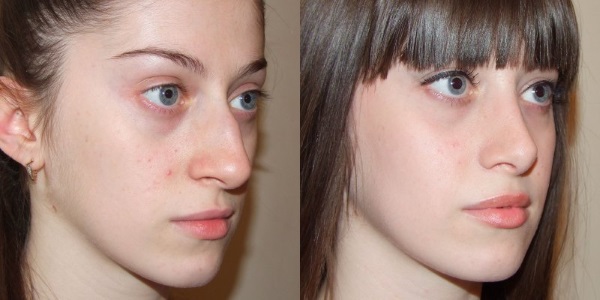
Backrest narrowing
Narrowing of the nasal dorsum is performed during an operation with a controlled fracture of the nasal bones (osteotomy). The surgeon moves the bones closer together, thereby reducing the width of the nasal dorsum.
Tip reduction
In a closed operation, the surgeon makes incisions inside the nose and removes part of the supporting cartilage. To achieve a narrow tip of the nose, the doctor will suture as needed to lift or tilt the cartilage.
Open surgery opens up more opportunities and simplifies work, but the rehabilitation period is significantly lengthened.

 Don't miss the most popular column article: How and why ribs are removed - efficiency, photos before and after surgery.
Don't miss the most popular column article: How and why ribs are removed - efficiency, photos before and after surgery.Preparing for surgery
Before undergoing nose reduction surgery (two weeks before), you need to undergo a standard medical examination.
For a complete check of the state of health, you must pass tests:
- blood (general and biochemical);
- blood for prothrombin;
- urine;
- blood test for rhesus factor and blood group;
- for acute viral diseases (HIV and hepatitis C).
You also need to do:
- ECG;
- tomography of the paranasal sinuses;
- pregnancy test for women;
- ultrasound diagnostics (not in all cases).
Before any surgery to reduce or correct the shape of the nose, it is necessary to undergo a complete examination
In addition to passing standard tests, additional examinations should be carried out, if necessary, in order to check the state of health as much as possible and determine all contraindications. The doctor is required to carry out tests for allergic reactions and review the medical history.
Immediately before rhinoplasty, you should consult with the surgeon, discuss all the nuances of the future operation to correct the nose, clearly and as deeply describe the desired result.
On the eve of the operation, it is recommended:
- stop taking anticoagulant drugs two weeks before surgery (blood thinning drugs) to avoid bleeding;
- eat only light and quickly digestible food (salads, fruits and dairy products) - the day before plastic surgery;
- stop eating food and liquids 6 hours before surgery;
- stop using alcohol and tobacco products one week before rhinoplasty.
On the eve of the operation, it is necessary to meet with an anesthesiologist to determine the method of anesthesia, check the patient for allergic reactions to anesthesia and make sure that there are no contraindications. The examination and check-up must be thorough as rhinoplasty is performed under general anesthesia.
Procedure progress
Based on the wishes of the patient, the degree of reduction of the nose (completely or in separate parts) and the nature of the incisions, the surgeon determines the technique of the operation. Immediately before the plastic surgery, he makes a marking of future incisions and discusses with the patient all the nuances of the operation and the desired result.
Stages of rhinoplasty:
- Anesthesia.
- Incision. Depending on the tasks and the method of the operation, the incisions are made inside the nose (closed) or outside (open). In the latter case, the surgeon cuts the columella (a strip of tissue that separates the nostrils). Through the incisions made, the soft tissues of the nose are removed, access to the cartilage and bone tissue opens.
- Reduction of the nose. The surgeon removes some of the cartilage and bone tissue. If necessary, removes part of the nasal bridge to reduce it.
- The hump of the nose. A part of the bone tissue (the hump itself) is removed with a special rasp.
- Correction of the width of the nostrils. The surgeon makes incisions and removes excess soft tissue, and distributes the wings of the nose closer to the midline.
- Correction of the septum of the nose. If necessary, the specialist straightens the nasal septum, which will ensure the normal physiological functioning of the nose.
- Closing incisions. Upon completion of all actions to reduce and adjust the size of the nose, tissues and skin are placed in place and sutures are performed.
- Fixation. Special splints and tubes are inserted to support the nose during the healing period. A special sticker made of plaster or pyroxylin (collodine) is applied to the nose, it will keep the shape of the nose.

 Don't miss the most popular column article: Cannula - what is it, how is it used in cosmetology and medicine.
Don't miss the most popular column article: Cannula - what is it, how is it used in cosmetology and medicine.Rehabilitation
The rehabilitation period after surgery to correct and reduce the size of the nose is divided into four stages.The first stage lasts the first week after rhinoplasty. This is the most difficult stage, since pain is felt in the first days, you need to constantly take antibiotics to avoid infection.
Dressings, plaster pads, and swabs in the nostrils prevent breathing through the nose. There is no way to go to work, do housework. Personal hygiene is inconvenient. On the face, bruising, bruising and tissue edema are pronounced.
The next stage lasts two weeks after the first stage of rehabilitation. At the beginning of this stage, the doctor removes the bandages and plaster of Paris, removes the tampons, and removes some of the stitches. The nose is washed with a special solution to remove blood clots and mucus from the cavity.
This makes breathing much easier. The swelling of the tissues is significantly reduced, the bruises practically disappear, but the nose remains swollen and deformed. During the first two stages, it is advisable to sleep only on your back so as not to damage your nose. It is forbidden to lift weights, bend over, eat hot food, or be in places with high temperatures.
The third stage lasts up to three months after the operation. The swelling of the nose becomes almost imperceptible, but it is not yet fully formed. Slightly swollen wings and tip of the nose are observed.
The fourth stage lasts from three months after rhinoplasty to one year. The period of complete rehabilitation depends on the characteristics of the patient's body and on the amount of work done to reduce the nose. After about a year, the nose will completely form and the result of the operation will be visible.
Possible complications
The result of the operation is influenced by many factors, ranging from the professionalism of the surgeon to the patient's activities during the rehabilitation period.
All sorts of complications after nose surgery can occur:
- Due to the fault of the surgeon, the nasal bone may be damaged, cartilage or skin. If an error was made in the operation, a second surgical intervention will be required to repair the damage.
- Divergence of seams. It depends not only on the professionalism of the doctor, but also on the patient's body, as well as on the careful attitude towards oneself during the rehabilitation period.
- Numbness. In the first days after the operation, numbness and loss of sensitivity in the nose is observed, as the surgeon made incisions that damaged the nerve endings. This is a temporary phenomenon.
- Hematomas and tissue edema. This is a natural phenomenon, since soft tissues were damaged during the plastic surgery. If the operation takes a long time and many changes have been made, the swelling can make breathing difficult. An experienced surgeon will prescribe medications that will ease the rehabilitation period.
- Infection. This is extremely rare. May be the result of insufficient disinfection of the patient's instruments and skin prior to rhinoplasty. A timely detected infection is successfully neutralized with antibiotics.
- Tissue necrosis. As a result of surgery, blood vessels are damaged, and blood stops flowing to the skin, bone or cartilage. This is what causes tissue death. In this case, a second operation is performed under local anesthesia to remove excess skin, bone or cartilage tissue. A long healing period can also lead to necrosis.
To avoid or reduce the likelihood of postoperative complications, several rules should be followed:
- do not smoke or drink alcoholic beverages before and after the operation;
- do not take drugs that reduce blood clotting;
- do not give in to stress, monitor your health, avoid pressure drops;
- protect the nose from damage;
- eat healthy and balanced food.
During the operation to reduce the nose, you can change the length and width of the nose, remove the hump. Despite the fact that this operation is one of the safest, complications are possible after rhinoplasty.
Rhinoplasty Videos
Photos of rhinoplasty before and after:
https://www.youtube.com/watch?v=4714Dmh5xmQ

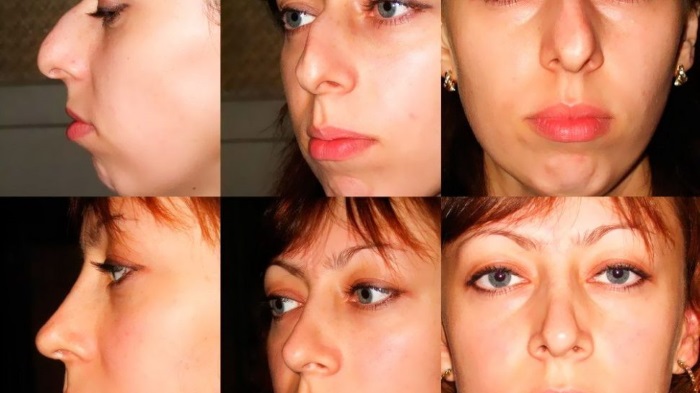
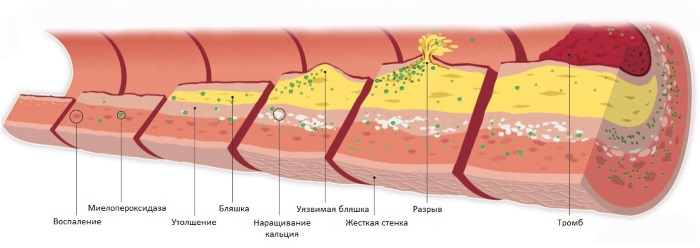


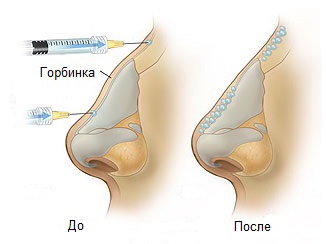
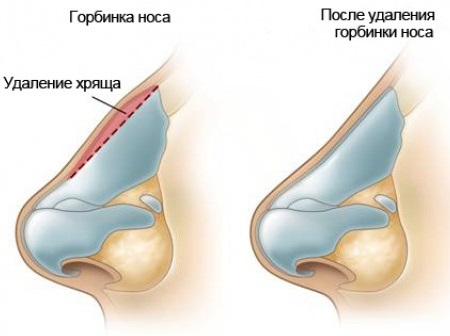
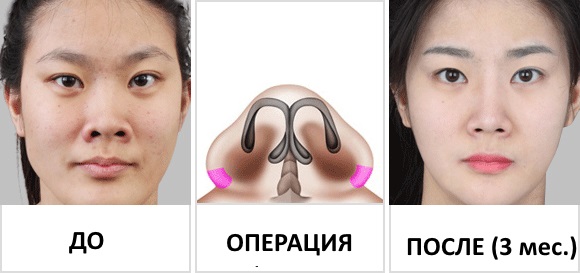
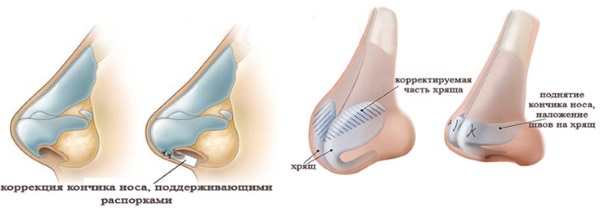

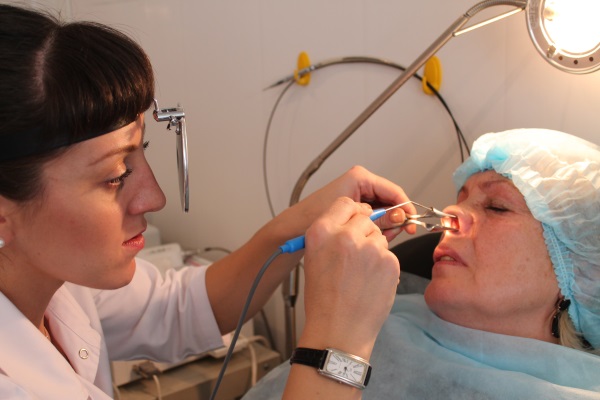
I really don't know if it's worth it to experience such pain in order to have a smooth and beautiful nose.
It does not hurt! After the OP - the nose does not hurt at all! The most difficult thing is to breathe when there are turundas in the nose. But this is only one night, so you can survive)
Hello, tell the doctor who made your nose. Thanks.
Anna. Which one did you do rhinoplasty?